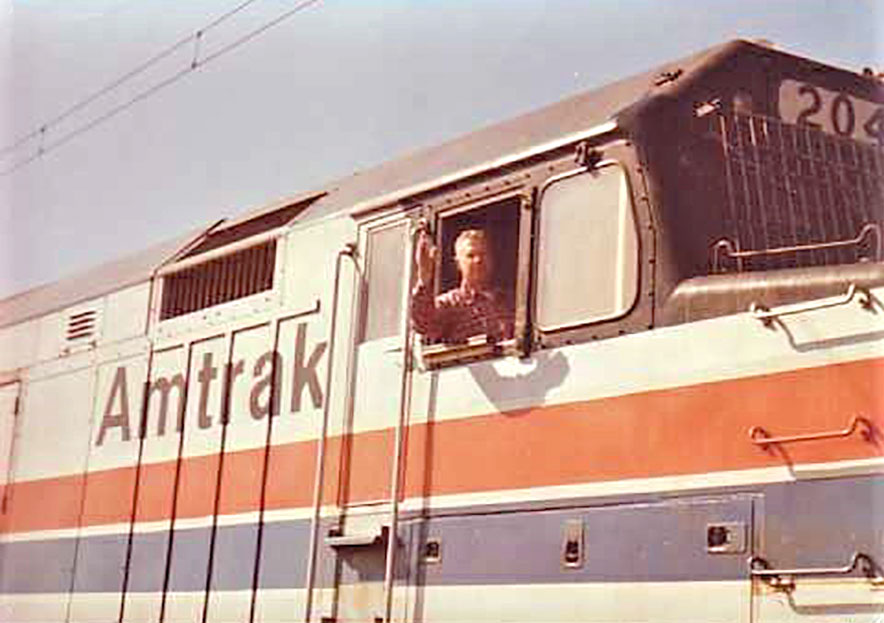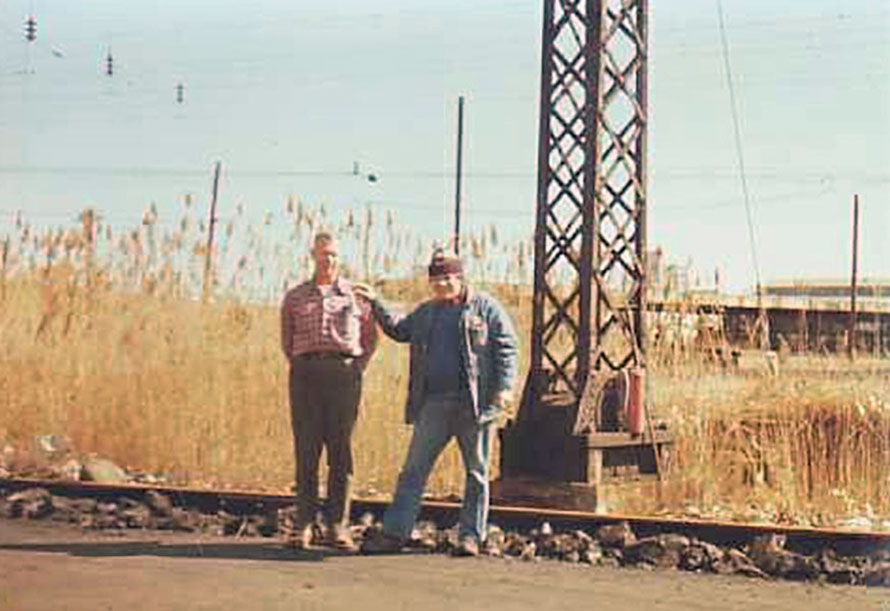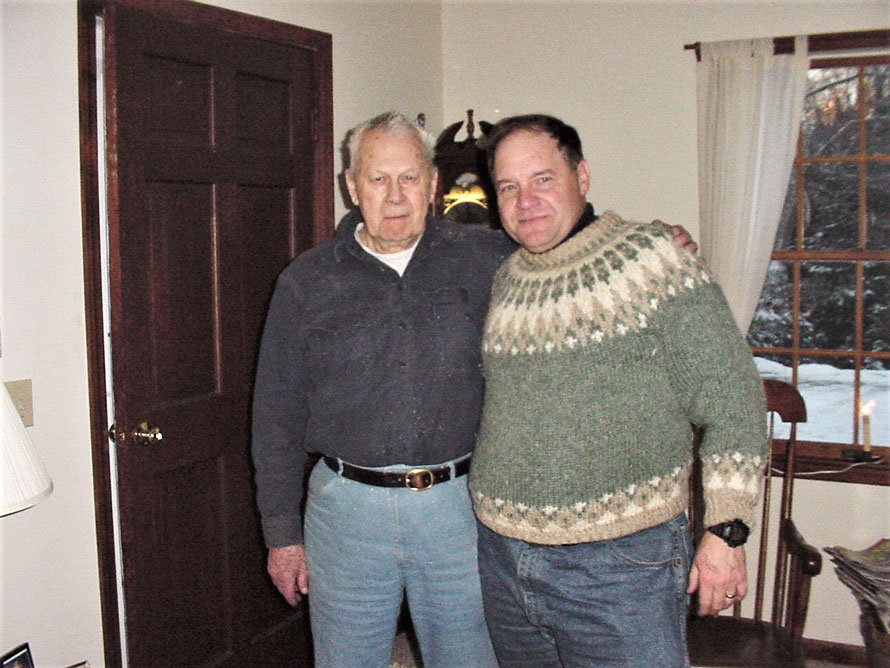When I was eleven years old, I was very lucky to have many engineers from the New York Central take me in the cab with them for train rides. Going east I rode the head end from North White Plains to New York City and went west as far as Chatham, New York in Duchess County. Today I can talk about it because none of the men I rode with can get fired for letting a kid in the cab. Sad to say, many of them have passed away and have gone off to Heaven where the trains never break down, all signals are clear and all the jobs work days with weekends off. Some of the jobs even pay overtime.

However, my story today is not about those men that were great to me as a kid. It’s about a special engineer that I fired for on the New Haven line. Back in 1973 I was lucky enough to be the firemen on NU-2, UN-1 with Norris Myers. We had a very good train crew. John Molyneux was the conductor, Bernie Sullivan was our head end brakeman and Eddy Sapinski was our flagman. Without a doubt they were one of the best crews I had the privilege of working with. This train crew could really make the best out of one work-horse of a job.
We reported at 8:00 P.M. at Cedar Hill engine house. We would go out and put our grip on the power and I would check out to make sure everything was ok on our three units. After a call to the yard master we would head for our train in the “departure yard.” While we were pumping air for our break test, our conductor would be making his calls. When we left, we knew just what we would do at all our stops the rest of the night. I mention this because later I worked with train crews that left much to be desired.
We would leave with about eighty to a hundred cars, and New London was our first stop. We always had to set off twice there, once in Fort Yard and once on the siding behind Groton Tower. You must understand that this was before radios so all our switching was done “in the blind.” You had to have a good ground crew to make these moves. Today, with radios just about anyone could do the job, but back then there could be one hell of a pile up if someone made a mistake. Even Jim, the tower operator at Groton Tower knew how to pass signals to us. He would blink the signal west of the tower to let us know when to stop and do it again to back up. These are tricks that the people I worked with on Amtrak probably could not do. There are no old-timers left to show them how.
After leaving New London, our train was light with only about twenty to thirty cars. This is where Norris first let me start running. My first night in the engineer’s seat it was so foggy you could not see ten feet in front of the engine. Prior to this night he had been asking me if I had done any “running” over the Shore Line. With a bit of a cocky attitude, I assured him I had and I knew what I was doing. So when he told me to come over to his seat that night little did I know how he was setting me up. I sat down and when I realized how different it would be running thirty cars and three freight engines in the fog, I knew I had shot my mouth off too much. After not blowing the horn at the next crossing Norris asked if I knew where we were. With my head down I mumbled something under my breath and he said perhaps he should take over. It was a humbling experience for me, something I have never forgotten.
We talked that night and he pointed out to me that to do this job right you had to look out the side windows. This way you could see landmarks that you could see during the daytime, and use them for landmarks. He taught me how to do the job right and feel confident in myself. After a few trips he put me in the seat again and I would run to Providence. We would drop all but ten or fifteen cars in the yard and pick up about fifty to sixty more. After leaving Providence Yard, we pulled back onto the main line at Lawn tower and headed east. After about fifteen miles we came to Attleboro, Massachusetts, and would be routed down the New Bedford Secondary track. After getting a clear block from Rick Murray in the tower and a big wave we would be on our way into “dark territory.” This is track that is run on paper work and no signals. We headed to Taunton where we made a set-off for a local freight that worked out of there. At that time there were about four or five railroad crossings you had to “stop and protect.” This meant we would stop. Bernie would come up and flag us across the crossing by lighting two fuses and dropping them on each side of the crossing. Bringing about sixty to seventy cars to a crawl to do this was something I had to learn because Norris did not want me to stop each time. After a while I got good at it and would not have to stop for this procedure to happen.

After Taunton we would go to Myricks, Masssaschusetts. This was a switch in the middle of no place where if you went left you would go to Middleboro, straight to New Bedford and right to Fall River. We would take our engines and about thirty-five cars and head to Fall River where we dropped them and “ran light” back to our train. We would tie back on and continue our trip to New Bedford where we dropped the train and put the engines at the engine house. Norris and I would walk to the Skipper Motel. Norris felt that after sitting all night it was good for our legs to do this, and he was right. After sleeping all day we would go out to dinner. Norris had a friend there who would take him to a great fresh fish take-out and he would bring back our dinners. Or the “Car Knocker,” a fellow named John, would let Norris take his car and we would all go out to eat at Louie’s on the wharf.
We would go to work at about 6:00 P.M. that night and head for home. We would do the same stops in reverse only we would be picking up the empties instead of dropping off loads. Many nights we would have to wait at Attleboro for westbound freight NE-97 to go by. During this time I would run up to the tower to use the phone and call my father to see how things were at home and tell him how I was doing. That’s how I got to know Rick Murray in the tower. Rick became a train dispatcher in Boston and I always would say hi to him since he let me tie up his phone so much. After a few years Rick went west to BNSF to be a dispatcher and I lost touch with him.
About a year and a half after meeting Norris I got “set up” as an engineer. I’m retired now and because of what engineers like Norris and other taught me, I was only in trouble one time for getting by a red signal and once for shooting my mouth off. Norris and I stayed friends for many years. My wife and I spent time with him and his wife at their farm in Vermont and I took him fly fishing several times. As he got older I had to give him a hand and he was always saying he did not want to bother me, but like I did with my father, I enjoyed helping him. It was not a problem at all. You see, both men played a big part in my life.

I think it’s very sad that more young people do not think back to the people that helped make them what they are today. Norris and most of the others that helped me along are gone now. I think of them at different times and smile and wish we could all sit around and have a drink and talk about the old days, They were great. We did our jobs took pride in them. Don’t get me wrong, I know many young people out on the railroad today that take a lot of pride and do a great job, but by working with men who were around in the days of steam as well as going through the Great Depression and WWII, it’s a lot different. I can only imagine today with all the cameras, microphones, and classes on what you can say and what you can’t say so you don’t offend anyone, I guess I saw the last of the best. Hope you enjoyed this story. As I have told people, I’m not a writer just a story teller.
This story first appeared in the Penn Central Post Magazine
John Springer – Photographs and text Copyright 2021
I was a spare board operator during the mid-1970s and occasionally handled this train at Attleboro and at Lawn tower. I don’t remember Rick Murray at Attleboro or at the Boston chief dispatcher’s office so he must have gone west by that time. I worked all of the locations that are mentioned in this article, Groton, Providence, Lawn, etc. The many sleepless nights (partially, we could doze during the quiet hours with the dispatcher’s consent) and times of stress were worth the experience. John is right: the old timers who taught me were wonderful and almost all of them took a fatherly interest in teaching and entertaining with their stories of the days of “steam and steel”.
When I was a kid growing up in New Bedford, the roundhouse and turntable were still in use, and the huge freight yard was always full of cars; the beautiful passenger station was a sight to behold with baggage wagons, Railway Express trucks still there. Rows of freight houses along Acushnet Avenue were a sign of prosperity, handling lcl shipments. As I grew older, it was very sad to see the railroad business dry up and most of the facilities fall into disuse and eventually removed. The gorgeous passenger depot was knocked down and replaced with … nothing.
Yes Fred the old timers were great to work with for sure. The buildings in New Bedford were just about gone when I fired the job in 73-74 the one building was there for us to sign up and for the yard crews I think at one time it had a bunk room upstairs.
John, I enjoyed reading about your experiences and the railroaders who took you under their wings. As a young teenager I had similar experiences from a CNJ operator and PRSL tower operator both at Winslow Jct., NJ. When I moved to Hamilton, ON, it was a couple of train crews on the Toronto, Hamilton & Buffalo that gave me my first cab rides. I was hooked. That led to a 39 year career with the Santa Fe and BNSF. In that time I fortunate enough to work with many more fellow employees who were very willing to share their knowledge. Some remain very close friends in retirement. You and I were truly blessed.
I am Kevin I had many experiences that I never gave much thought to at the time but I sure know now. Sounds like you had a good life also
Excellent piece John. A great stroll down memory lane from happier times
Great post! Many thanks!
“I’m not a writer, just a story teller” — no JUST about it, John: Your stories bring the past to life, and we enjoy them immensely. Keep them coming!
Everything we have today is built on what those before us were willing to do and, sadly, many of us don’t realize it until our youth is in the rearview mirror. Nice to know that you had that time with the men who taught you so much. Thanks for sharing!
John – In the late 60s I too rode UN-1 and reverse, but I rode the Old Colony side of the job that went on duty at New Bedford and rested at New Haven. Bob Tweedy was the engineer (also the Engineer’s local chairman) who was also an expert and always ready to befriend younger people, both employees and fans. Just to refresh your memory…the divide between the Middleboro and New Bedford lines was on the south side of Taunton at Cotley Jct………Myricks was the divide between the New Bedford and Fall River lines. It was still New Haven when I rode the job….Cotley to Whittendon Jct was CTC (removed by PC), and there was a nightly ballet between UN-1 and SK-1 (S Braintree – Framingham) exchanging cars at the small yard at Danforth Street (Taunton), as well as picking up cars from the locals as well. Fall River had a train of their own, which I think was a FR-Taunton-FR turnaround that ran in the daylight. Great to remember those days!!